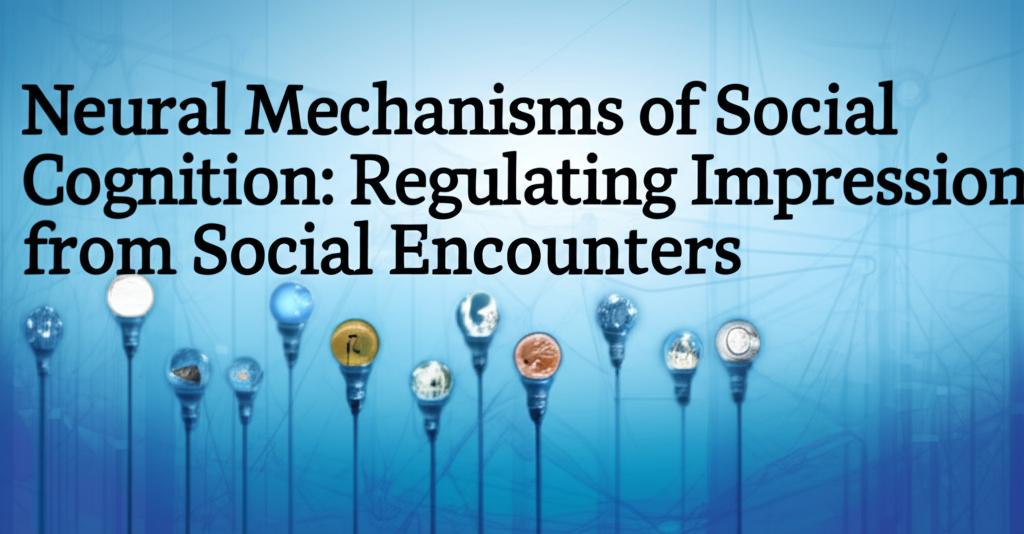Navigating the social world requires us to constantly form and update impressions of the people we meet. This complex process, known as social cognition, involves a dynamic interplay of brain regions and neural mechanisms. Recent research sheds light on how our brains create initial judgments, adapt these impressions in light of new information, and regulate our behavior in social encounters.
Forming First Impressions: A Swift Neural AssessmentOur brains are wired to make rapid assessments of others. Within milliseconds of seeing a new face, a network of brain regions associated with social cognition springs into action. Key players in this initial evaluation include:
- The Amygdala: This region is crucial for processing emotions and plays a significant role in forming initial impressions, particularly those related to trustworthiness. It responds strongly when encoding social information that aligns with our subsequent evaluations.
- The Prefrontal Cortex (PFC): This area, particularly the medial prefrontal cortex (mPFC), is heavily involved in higher-level social cognitive processes. The dorsomedial prefrontal cortex (dmPFC) is consistently activated when we form impressions based on behavioral information. Different parts of the PFC are engaged depending on whether we perceive someone as trustworthy, competent, or aggressive.
- The Posterior Cingulate Cortex (PCC): Similar to the amygdala, the PCC shows stronger responses when processing social information consistent with later judgments, highlighting its role in shaping those first impressions.
- Other Involved Regions: The temporoparietal junction (TPJ) aids in understanding others' mental states, while the posterior superior temporal sulcus (pSTS) becomes active when observing faces and movements. The fusiform face area (FFA) in the lateral occipitotemporal gyrus is specifically responsive to faces.
Interestingly, our brains seem predisposed to social thinking. Even during periods of rest or dreaming, the dmPFC is active, potentially processing recent social experiences and preparing us to interpret the world in terms of others' thoughts and feelings.
The Dynamic Nature of Impressions: Updating Our ViewsFirst impressions are not set in stone. Social interaction is an ongoing process, and we continually receive new information that may confirm or contradict our initial assessments. The brain possesses sophisticated mechanisms for this "impression updating":
- The Dorsomedial Prefrontal Cortex (dmPFC): This region isn't just involved in forming initial impressions; it also plays a key role in updating them, especially when new information is inconsistent with an existing impression.
- A Wider Network for Inconsistency: When faced with behaviors that contradict our initial evaluation of someone, a broader network of brain regions is recruited. This includes the rostrolateral prefrontal cortex (rlPFC), superior temporal sulcus (STS), right inferior parietal lobule (IPL), and posterior cingulate cortex (PCC). These areas work together to revise our understanding of the person.
- The Hippocampus: Assigning Emotional Value: Recent research highlights the hippocampus, a brain region critical for memory and learning, in assigning positive or negative emotional value (valence) to social experiences. Within the ventral CA1 subregion of the hippocampus, neuromodulators like serotonin and neurotensin play opposing roles. Serotonin, acting on the serotonin 1B receptor, tends to generate a positive impression of a social encounter, while neurotensin, acting on the neurotensin 1 receptor, is associated with negative impressions. This mechanism allows for the flexible updating of social information based on new encounters.
This ability to update impressions is crucial for navigating a constantly changing social environment and predicting others' behavior. Our brains are like time machines, often relying on past information to process the present, which is usually efficient but can occasionally lead to "change blindness" where we might miss immediate changes because we're anchored to our initial impression.
Impression Management: Shaping Others' PerceptionsBeyond forming impressions of others, we also actively try to influence how others see us – a process called impression management. While the neural underpinnings of this are still being explored, key factors include:
- Social Observation: Knowing we are being watched often triggers impression management strategies. The rostromedial prefrontal cortex (rmPFC) is consistently activated during social observation and when engaging in socially desirable behaviors.
- Socially Desirable Responding: Under observation, individuals tend to evaluate themselves and their friends in a more socially desirable light, such as downplaying negative traits in themselves and emphasizing positive traits in friends.
- Emotional Regulation: Suppressing or modifying emotional responses in certain social settings is a common impression management tactic.
Understanding the neural mechanisms of social cognition has significant implications. Deficits in these processes are often seen in neuropsychiatric disorders like autism spectrum disorder (ASD) and schizophrenia. For instance, an imbalance in the processing of positive and negative social experiences, potentially linked to the serotonin and neurotensin systems in the hippocampus, could contribute to social difficulties. Research showing that activating specific serotonin receptors can restore positive emotional value in mouse models of ASD offers hope for developing targeted therapies.
The field of social neuroscience is continually evolving. While much has been learned from studying individual brains, there's a growing emphasis on "online" social cognition – investigating brain activity during real-time social interactions. This involves understanding how two or more brains synchronize and influence each other during dynamic social exchanges.
In summary, our ability to form and regulate impressions from social encounters is a sophisticated cognitive function supported by a complex network of brain regions and neurochemical systems. From the rapid formation of first impressions to the continuous updating of these views and our efforts to manage how others perceive us, the brain is constantly working to help us navigate the intricate landscape of human social life. Further research in this area will undoubtedly deepen our understanding of social behavior and its neural basis, potentially leading to new interventions for social cognitive impairments.

